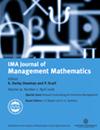Cost-based performance optimization of a single system under a hierarchical imperfect maintenance policy
IF 4.3
3区 工程技术
Q3 MANAGEMENT
引用次数: 0
Abstract
Due to the influence from external factors such as repair sites and seasonal climate change, it is difficult to restore the system performance to any intermediate level between perfect maintenance and minimal maintenance through imperfect maintenance. This article first categorizes the states of the system just before repair into three classes based on its internal degradation level: failure, major defect, and minor defect, with three corresponding thresholds. Subsequently, the corresponding repairs are carried out to dwindle the system’s degradation to different levels. In detail, if the internal degradation level of the system just before repair is recognized as minor defect, an imperfect repair, termed as type I imperfect repair, is implemented to scale down the degradation level below the minor defect threshold. If the degradation level is identified as major defect, an upgraded imperfect repair, termed as type II imperfect repair, is executed to only lower the degradation to the level between the minor defect threshold and major defect threshold. Otherwise, if the degradation before repair is beyond the failure threshold, replacement will be carried out instead of these imperfect repairs. Thus, a novel hierarchical imperfect maintenance structure is introduced. Then, a multi-variable repair cost model is constructed when considering the related costs incurred from inspection, type I imperfect repair, type II imperfect repair, replacement, and even system downtime. Finally, with the aid of the stationary law of Markov chains and the semi-regenerative process, the cost-based performance optimization with three parameters, including the inspection interval, minor defect threshold, and major defect threshold, is explored through a numerical experiment, and the closed expression of the optimal cost rate is provided.分层不完善维护政策下基于成本的单一系统性能优化
由于维修地点和季节性气候变化等外部因素的影响,通过不完全维修很难将系统性能恢复到完美维修和最小维修之间的任何中间水平。本文首先根据系统的内部退化程度,将维修前的系统状态分为三类:故障、重大缺陷和轻微缺陷,并设定了三个相应的阈值。随后,进行相应的维修,将系统的退化程度降低到不同的水平。具体来说,如果修复前系统的内部退化水平被认定为轻微缺陷,则会实施不完美修复(称为 I 型不完美修复),将退化水平降至轻微缺陷阈值以下。如果退化水平被认定为主要缺陷,则执行升级的不完美修复(称为 II 型不完美修复),仅将退化水平降至小缺陷阈值和主要缺陷阈值之间的水平。否则,如果修复前的劣化程度超过了故障阈值,则将执行替换,而不是这些不完美修复。因此,引入了一种新的分层不完全维修结构。然后,考虑到检查、第一类不完善维修、第二类不完善维修、更换甚至系统停机时间所产生的相关成本,构建了一个多变量维修成本模型。最后,借助马尔可夫链的静态规律和半再生过程,通过数值实验探讨了基于成本的性能优化,包括检查间隔、小缺陷阈值和大缺陷阈值三个参数,并给出了最优成本率的封闭表达式。
本文章由计算机程序翻译,如有差异,请以英文原文为准。
求助全文
约1分钟内获得全文
求助全文
来源期刊

IMA Journal of Management Mathematics
OPERATIONS RESEARCH & MANAGEMENT SCIENCE-MATHEMATICS, INTERDISCIPLINARY APPLICATIONS
CiteScore
4.70
自引率
17.60%
发文量
15
审稿时长
>12 weeks
期刊介绍:
The mission of this quarterly journal is to publish mathematical research of the highest quality, impact and relevance that can be directly utilised or have demonstrable potential to be employed by managers in profit, not-for-profit, third party and governmental/public organisations to improve their practices. Thus the research must be quantitative and of the highest quality if it is to be published in the journal. Furthermore, the outcome of the research must be ultimately useful for managers. The journal also publishes novel meta-analyses of the literature, reviews of the "state-of-the art" in a manner that provides new insight, and genuine applications of mathematics to real-world problems in the form of case studies. The journal welcomes papers dealing with topics in Operational Research and Management Science, Operations Management, Decision Sciences, Transportation Science, Marketing Science, Analytics, and Financial and Risk Modelling.
 求助内容:
求助内容: 应助结果提醒方式:
应助结果提醒方式:


